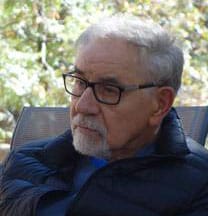People twirl ecstatically, eyes closed, repeating, in a call-and-response fashion, chants led by Rabbi Andrew Hahn, who plays a harmonium while others play guitars and percussion instruments — repetitive, hypnotic sounds that seductively nudge the crowd, young and old alike, to sway and swirl and chant.
It looks like an Indian Kirtan, a participatory mystical-devotional practice in which Sanskrit mantras are chanted to dronelike musical accompaniment. But this Kirtan is different: Hahn, 52, chants in Hebrew, using traditional Jewish prayers. As his Web site says, Hahn’s “vocation is to make Torah accessible … in a way that is participatory and memorable.”
Based in New York, Hahn is touring Southern California shuls, as well as yoga studios and New Age centers. His main local event will be on March 5, at Temple Emanuel of Beverly Hills. Hahn’s Web site advises participants to “bring your open hearts, voices and dancing socks to a full band full-on rocking Kirtan.”
In an interview, Hahn talked about the remarkable process that took a self-proclaimed “academic pinhead” from his scholarly Jewish roots to become a leader of ecstatic participatory musical/spiritual events.
Early on, Hahn hoped for a career as a classical guitarist, studying music at Carnegie Mellon University and even spending time in Uruguay with a classical guitar master. Then, setting this path aside, he pursued an academic career, earning a doctorate in Jewish thought at New York’s Jewish Theological Seminary. And then, moving in yet another direction, he received his rabbinic ordination at Hebrew Union College-Jewish Institute of Religion.
In 2003, as a freshly minted scholarly rabbi in his 40s, he set about looking for rabbinic work, imagining that he would be writing sermons. But it didn’t turn out that way.
“For reasons that are still mysterious to me, I couldn’t find a job, either in the academic Jewish world or in the rabbinic world,” Hahn said. “I just wasn’t fitting in anywhere. … You could say that God wanted me to do something different.”
Frustrated, Hahn moved to Colorado, where his brother lives. Feeling “down, really low, in the pits,” he started attending study sessions with the founder of the Jewish Renewal movement, Reb Zalman Schachter-Shalomi. Hahn was skeptical. “I wasn’t really a follower, more of a misnaged [opponent], really. But I just started going, and I was completely amazed by him and his ability with text. … My understanding of what Judaism could be was being expanded.”
At the same time, Hahn was exposed to Kirtan chanting in its Sanskrit form. Just as he had been skeptical about Reb Zalman at first, Hahn initially was unmoved by Kirtan chanting. When he first heard it, he said, “I was like a yeshiva bocher — I just didn’t get it.” But one day, feeling “depressed,” he listened to a Kirtan CD, and “it was very uplifting, that deep devotional chanting. It made me really happy.”
It was a transforming experience. “I ordered a harmonium,” Hahn said, “and started to go to Kirtans and observe and listen and become familiar with it and become a part of that community.”
Little by little, drawing on “the ecstatic energy of Shlomo Carlebach niggunim [melodies],” as well as the Hebrew chants he’d heard in New York’s B’nai Jeshurun Synagogue, Hahn made the connection between Kirtan chanting and his own tradition. “The part of Judaism that always grabbed me,” Hahn said, “besides the ideas, was the music and Shabbos and the singing around the table. … So I thought, ‘Wow, this would be amazing in Hebrew.’ ”
Using traditional Jewish liturgy, Hahn began to create Kirtan-style chants in Hebrew. “Eventually, I called synagogues,” he said, “and asked if they wanted me to do it. … I picked up a percussionist along the way, and it just started to grow.
“The form of call-and-response works very well in Hebrew … in Jewish liturgical music. I’ve done some research, and there was some kind of call-and-response chant or antiphonal kind of singing, probably in the Second Temple period, some of the psalms. There’s precedent for it in the Jewish tradition.
“Hebrew is considered what is called a vibrational language, along with Sanskrit, meaning that the Hebrew language itself has certain vibrational sounds,” sounds that resonate with the senses. “Anyone who has sat around a Shabbos table knows that the Hebrew language is meant to be chanted.”
Hahn said that, in late 2006, “for the heck of it,” he telephoned a large yoga studio in New York, told them he was a rabbi and asked if they would host a Kirtan in Hebrew. They agreed, and a large crowd showed up. That studio has asked him back many times since then.
“My main mandate is to the Jewish world,” Hahn said, “to bring this kind of yogic, devotional, sometimes contemplative, sometimes ecstatic, totally participatory chant — and fun — to the Jewish world.”
At the same time, Hahn said, he brings “Torah and kabbalah and Jewish wisdom to the yoga world and the New Age community. So I have a dual track, and it’s quite a blessing.”
Hahn said that his road to becoming the Kirtan Rabbi evolved slowly but inexorably. “It’s become my way to be a rabbi, my rabbinate. It’s not like I left behind my Ph.D. or my rabbinic studies. [Kirtan] became my way to bring my background into my music. It was a return to music for me, because I’d started out, way back when, as a classical musician.
“The real lesson in life in all this is that nothing gets lost. You can have everything back again if you say, ‘Yes, I can do this.’ ”
For more information about the Kirtan Rabbi’s schedule, the CDs or to see videos of past events, visit kirtanrabbi.com or call (212) 663-4160.























 More news and opinions than at a Shabbat dinner, right in your inbox.
More news and opinions than at a Shabbat dinner, right in your inbox.